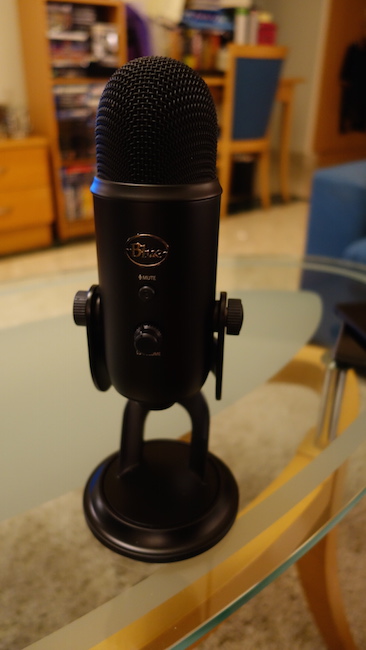
Blue Microphones Yeti USB Microphone Review
Create unparalleled recordings with your computer using Blue’s best-selling Yeti family of USB microphones. Thanks to our proprietary tri-capsule technology, Yeti microphones produce pristine, studio-quality recordings with legendary ease. And four different pattern settings offer incredible flexibility so you can record vocals, instrumental music, podcasts, audio for video, interviews, or even cryptozoology lectures in ways that would normally require multiple microphones. Whether you’re recording at home, on the road, or in the Himalayas, Yeti helps you produce studio-quality recordings every time.
Introduction:
I love the naming convention that goes with Blue Microphones’ product line. From the Snowflake, to the Snowball, now we have the Yeti. It’s a huge desktop microphone that is almost 12 inches tall and definitely heavy. The size also gives you a preview on how this beast performs (it’s awesome) and can ultimately be one of best desktop microphones we have test.
Manufacturer’s Specification:
- Power Required/Consumption: 5V 150mA
- Sample Rate: 48 kHz
- Bit Rate: 16bit
- Capsules: 3 Blue-proprietary 14mm condenser capsules
- Polar Patterns: Cardioid, Bidirectional, Omnidirectional, Stereo
- Frequency Response: 20Hz – 20kHz
- Max SPL: 120dB (THD: 0.5% 1kHz)
- Dimensions (extended in stand): 12 x 12.5 x 29.5 cm
- Weight (microphone): 0.55 kg
- Weight (stand): 1 kg
- Impedance:16 ohms
- Power Output (RMS): 130 mW
- THD: 0.009 %
- Frequency Response: 15 Hz – 22 kHz
- Signal to Noise: 100dB
Design and Specifications:
The Yeti builds upon a stable and proven design reminiscent of those studio-grade microphones. It comes in a stable base that prevents it from wobbling on top of your desk. Additionally, the Yeti comes in a three-capsule design that is actually one of the key elements that make the microphone great.
There’s a volume control that also includes a mute button and at the back you will find a control for tuning the mic gain. One of the key features of the Yeti is the selector switch that lets you choose four recording modes: omnidirectional, cardioid pattern, stereo and bidirectional mode.
Omnidirectional mode, which lets the Yeti pick up sound from all directions and cardioid where it picks up sound directly from the microphone, were features already present on other models in the Blue Microphones line. Stereo and bidirectional mode are new additions, wherein stereo records sound from two channels while bidirectional mode will enable you to pick up and record sound from either the back or the front the Yeti.
At the bottom of the Yeti, you will find the USB port for connecting the microphone to the computer (a cable is also included). Also present is a 3.5 mm headphone jack so you can listen to yourself talk in real time.
Setup:
Since the Yeti uses USB, it’s as simple as plugging in the device and your PC will recognize it instantly. The Yeti is compatible with computers running Windows 10, Windows 8 (including 8.1), Windows 7, Windows Vista, Windows XP (Home and Professional), and Mac OS X (10.4.11 or higher).
Performance:
Seeing as that I still feel weird hearing my own voice, the Yeti does an outstanding job making my voice sound better than I occasionally hear. Voices are clear all throughout, with no sound of distortion. My voice was consistent with every mode I’ve tried the microphone on – but the additional modes allow it to capture more background noises accurate to each direction. I could go on and on telling you how good the Yeti but it’s best to hear it to believe it.
Supplied Accessories:
- Blue Microphone Yeti
- USB cable
- User manual
Pros & Cons:
Pros
- Excellent sound quality
- Various recording modes
Cons
- Big and heavy
Conclusion:
The Blue Microphones Yeti builds upon the company’s reputation of making high audio equipment. Perfect for podcasts or other types of recording, it’s easily one of the best professional microphones we’ve tested in a while.
